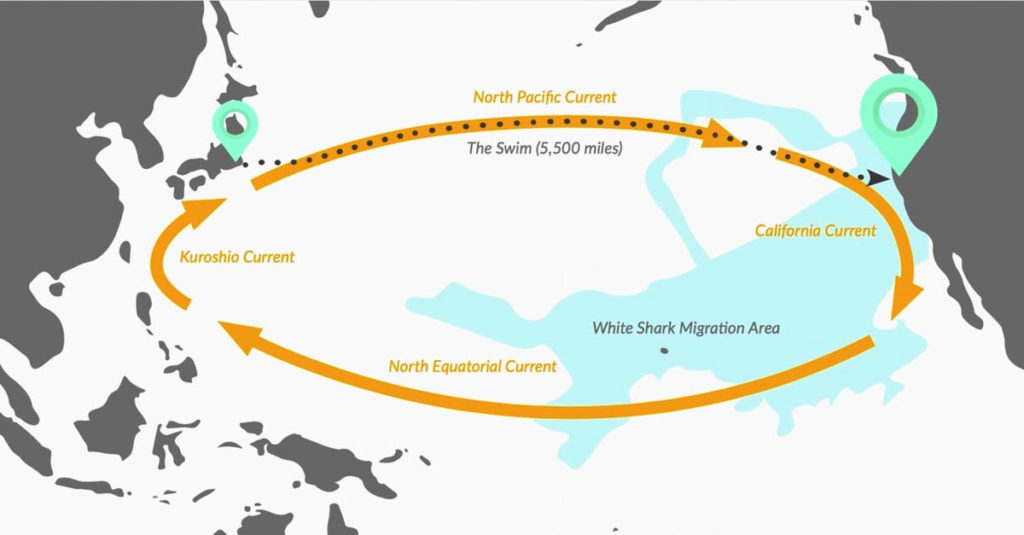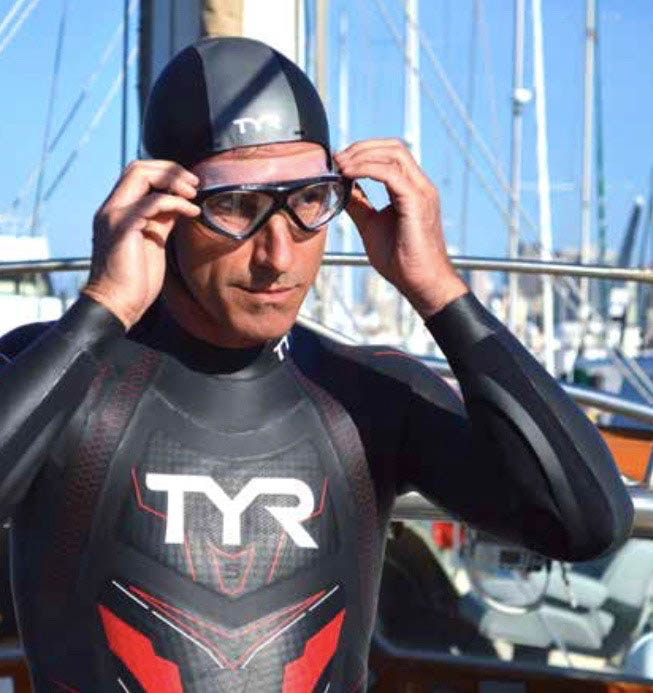It will take seven weeks for Ben Lecomte to reach Japan from California. It will take six to eight months for him to get back. By swimming.
For eight hours a day during that long return trip, Lecomte, 51, will be in the water. It’s estimated he’ll burn 8,000 calories a day and spend 1,400 hours in the ocean in his attempt to become the first person to swim across the Pacific.
“Ben has this very weird passion of swimming in the ocean. It’s very hard to explain, even for him,” said Paul Lecomte, Ben’s nephew and the project manager of the expedition dubbed The Longest Swim. In 1998, Lecomte became the first person to swim across the Atlantic Ocean when he completed a 73-day, 5,980-km (3,716-mile) journey from Cape Cod, Massachusetts, to Quiberon, France.
That looks like a warm-up for the Pacific swim, which will cross across 8,900km (5,530 miles) of ocean. It took seven years for Ben Lecomte, who is currently sailing to Tokyo with his crew and could not be reached for comment, to organize the expedition. During the swim, slated to start in late May, the team hopes to raise awareness of the impact humans are having on the ocean. But along the way the swimmer and his crew will also be collecting data on ocean conditions that will be shared with researchers in at least 20 scientific institutions.
That aspect of the mission makes it unique in an age of autonomous gliders, unmanned underwater drones, satellite-connected floats, remote-sensing technologies and ever newer and faster and longer-lasting and more independent devices collecting scientific information from the world’s oceans. Ben Lecomte’s efforts will be the opposite: slow, on-site, requiring plenty of people power and taking up most of a year.
But the result will be data collected at very precise points across a whole ocean, and the Lecomtes and the scientists they’re working with think that will make it valuable.
“It’s a unique setup for scientists – to collect very high-definition data across the ocean, which has not been done before,” said Paul Lecomte. He noted that since the crew are not professional scientists they hope their work will also encourage people to become citizen scientists. “Everybody with a boat can potentially contribute to research.
“We didn’t come up with the ideas” for the data collection efforts, he added. “We said. ‘We have a boat and are going very slow for very long and have this amount of space and time.’ (The scientists) came up with the ideas and sent us the equipment.”

Among the equipment will be a RadBand that Ben Lecomte will wear on his leg while swimming and that will assess concentrations of radioactive cesium in the water each day; an EKG monitor that will record his heart activity throughout the day; a large rectangular net, as well as filters and storage and imaging equipment to collect and classify microplastics and microfibers; and hydroacoustic devices that will record marine mammal sounds in the ocean at night to determine their abundance. He will also wear a magnetic shark-repellent bracelet, as his route will take him through a great white shark migration area.
Ben Lecomte will be shadowed by a sailboat, on which he’ll sleep at night. A small rigid-hulled inflatable boat propelled by an electric outboard engine will follow him during his daily swims. From those boats and devices attached to Lecomte, the team will gather data on ocean-related conditions: water salinity, temperature, acidity and oxygen content. They will also monitor cyanotoxins; radiation from the Fukushima disaster; abundance of some types of “giant” phytoplankton; and seabird distribution.
The crew will also tag some large pieces of debris they find with a GPS device to track how debris moves in the Pacific. They will also collect and classify microplastics so scientists can determine how they break down and are colonized by microbes. The team will capture microfibers to track their distribution and deterioration. They’ll also catch various fish species and store the flesh so that back on shore researchers can try to determine the ratio of flesh to microfiber in the fish people eat.
These citizen scientists will also track how Lecomte physically and psychologically endures the swim. (A team of doctors on land will also monitor his condition.) And since he will be essentially experiencing low-gravity conditions by floating for so long each day, NASA scientists are curious to see if they can learn anything about the effects of space travel from his physiological data.
Whether all that data will prove useful remains to be seen.
“I think projects like this can be really valuable, but I think the value is mainly in outreach,” says Mark Schrope, director of Schmidt Marine Technology Partners, a program of the Schmidt Family Foundation that funds early-stage ocean technology startups.

Schrope, who isn’t involved in the Longest Swim project, doesn’t believe the slow speed and long distance of the swim make the data particularly unique. “I don’t think the speed of the data gathering is an issue – the drones are often only moving at a knot or so,” he said. “I think it’s more that the path isn’t chosen according to scientific needs, and, more importantly, that the collection won’t be repeated.”
Lecomte’s journey will take him across the North Pacific. He’ll be going east to west because that’s how the currents flow – starting in the Kuroshio Current, hooking up with the North Pacific Current and hitting San Francisco via the California Current.
That route will take him through the top of the North Pacific gyre of the massive – and growing – great Pacific garbage patch for about 1,600km (1,000 miles) of his swim.
The microplastics breaking down there “create, like, a fog underwater,” said Paul Lecomte. “You don’t necessarily see it out of the water, but Ben will be swimming in it.”
That extended time up close and personal with marine plastic pollution may produce some of the most valuable data from the trip.
Erik Zettler, a marine microbiology researcher with Utrecht University and the Royal Netherlands Institute for Sea Research, will extract DNAfrom the microplastics Ben Lecomte’s team has collected and preserved to determine what microbes are living on them and what they might be doing there.
“We are curious about the geographical variation of the ‘plastisphere’ community, as well as how it varies on different types of plastic, as well as whether there are any potentially disease-causing organisms or algae that can cause harmful algal blooms,” Zettler said.
He says what’s most valuable about the data Lecomte’s crew will collect is “the location and excellent geographic transect it will provide across an area of the ocean that is not very well sampled for this purpose.”
But the main outcome the crew hopes for is increased awareness of the importance of the oceans to human welfare, particularly through outreach programs that will allow classrooms to follow Lecomte’s progress and work with some of the data collected.
“If Ben doesn’t swim in the ocean, it’s like removing a part of his identity,” Paul Lecomte said. “Ben has this very weird and extreme connection with the water and the ocean, but we all have a connection to the ocean in some way. It’s important to protect it.”
Learn more at: https://www.newsdeeply.com






